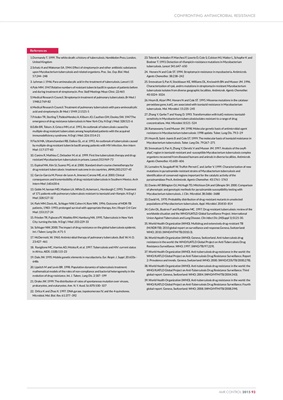
CONFRONTING ANTIMICROBIAL RESISTANCE
AMR CONTROL 2015 93
References
1.dormandy T. 1999. The white death: a history of tuberculosis. Hambledon Press, London,
United Kingdom
2.schatz A and Waksman SA. 1944. Effect of streptomycin and other antibiotic substances
upon Mycobacterium tuberculosis and related organisms. Proc. Soc. Exp. Biol. Med.
57:244-248
3. Lehman J. 1946. Para-aminosalacylic acid in the treatment of tuberculosis. Lancet i:15
4.pyle MM. 1947.relative numbers of resistant tubercle bacilli in sputum of patients before
and during treatment of streptomycin. Proc Staff Meetings Mayo Clinic ;22:465
5.medical Research Council. Streptomycin treatment of pulmonary tuberculosis. Br Med J
1948;2:769-82
6.medical Research Council. Treatment of pulmonary tuberculosis with para-aminosalicylic
acid and streptomycin. Br Med J 1949; 2:1521-5
7.frieden TR, Sterling T, PablosMendez A, Kilburn JO, Cauthen GM, Dooley SW. 1947.the
emergence of drug resistance tuberculosis in New York City. N Engl J Med; 328:521-6
8.edlin BR, Tokars JI, Grieco MH, et al. 1992. An outbreak of tuberculosis caused by
multiple-drug resistant tuberculosis among hospitalized patients with the acquired
immunodeficiency syndrome. N Engl J Med ;326:1514-21
9.fischl MA, Uttamchandani RB, Daikos GL, et al. 1992. An outbreak of tuberculosis caused
by multiple-drug resistant tubercle bacilli among patients with HIV infection. Ann Intern
Med ;117:177-83
10. Coninx R, Mathieu C, Debacker M, et al. 1999. First line tuberculosis therapy and drugresistant
Mycobacterium tuberculosis in prisons. Lancet;353:969-73
11. Espinal MA, Kim SJ, Suarez PG, et al. 2000. Standard short-course chemotherapy for
drug resistant tuberculosis: treatment outcome in six countries. JAMA;283:2537-45
12. Garcia-Garcia M, Ponce-de-Leon A, Jimenez-Corona ME, et al. 2000. Clinical
consequences and transmissibility of drug resistant tuberculosis in Southern Mexico. Arch
Intern Med ;160:630-6
13. Goble M, Iseman MD, Madsen LA, White D, Ackerson L, Horsburgh C.1993. Treatment
of 171 patients with pulmonary tuberculosis resistant to isoniazid and rifampin. N Engl J
Med ;328:527-32
14. Park MM, Davis AL, Schluger NW, Cohen H, Rom WN. 1996. Outcome of MDR-TB
patients, 1983-1993: prolonged survival with appropriate therapy. Am J Respir Crit Care
Med ;153:317-24
15. Frieden TR, Fujiwara PI, Washko RM, Hamburg MA. 1995. Tuberculosis in New York
City: turning the tide. N Engl J Med ;333:229-33
16. Schluger NW, 2000. The impact of drug resistance on the global tuberculosis epidemic.
Int J Tuberc Lung Dis ;4:71-5
17. McDermott, W. 1960. Antimicrobial therapy of pulmonary tuberculosis. Bull. W. H. O.
23:427-461
18. Raviglione MC, Harries AD, Msiska R, et al. 1997. Tuberculosis and HIV: current status
in Africa. AIDS ;11(B):115-23
19. Dale JW. 1995. Mobile genetic elements in mycobacteria. Eur. Respir. J. Suppl. 20:633s-
648s
20. Lipsitch M and Levin BR. 1998. Population dynamics of tuberculosis treatment:
mathematical models of the roles of non-compliance and bacterial heterogeneity in the
evolution of drug resistance. Int. J. Tuberc. Lung Dis. 2:187-199
21. Drake JW. 1999. The distribution of rates of spontaneous mutation over viruses,
prokaryotes, and eukaryotes. Ann. N. Y. Acad. Sci.870:100-107
22. Drlica K and Zhao X. 1997. DNA gyrase, topoisomerase IV, and the 4-quinolones.
Microbiol. Mol. Biol. Rev. 61:377-392
23. Telenti A, Imboden P, Marchesi F, Lowrie D, Cole S, Colston MJ, Matter L, Schopfer K and
Bodmer T. 1993. Detection of rifampicin-resistance mutations in Mycobacterium
tuberculosis. Lancet 341:647-650
24. Honore N and Cole ST. 1994. Streptomycin resistance in mycobacteria. Antimicrob.
Agents Chemother. 38:238-242
25. Sreevatsan S, Pan X, Stockbauer KE, Williams DL, Kreiswirth BN and Musser JM. 1996.
Characterization of rpsL andrrs mutations in streptomycin-resistant Mycobacterium
tuberculosis isolates from diverse geographic localities. Antimicrob. Agents Chemother.
40:1024-1026
26. Heym B, Alzari PM, Honore N and Cole ST. 1995. Missense mutations in the catalaseperoxidase
gene, katG, are associated with isoniazid resistance in Mycobacterium
tuberculosis. Mol. Microbiol. 15:235-245
27. Zhang Y, Garbe T and Young D. 1993. Transformation with katG restores isoniazidsensitivity
in Mycobacterium tuberculosisisolates resistant to a range of drug
concentrations. Mol. Microbiol. 8:521-524
28. Ramaswamy S and Musser JM. 1998. Molecular genetic basis of antimicrobial agent
resistance in Mycobacterium tuberculosis: 1998 update. Tuber. Lung Dis. 79:3-29
29. Heym B, Saint-Joanis B and Cole ST. 1999. The molecular basis of isoniazid resistance in
Mycobacterium tuberculosis. Tuber. Lung Dis. 79:267-271
30. Sreevatsan S, Pan X, Zhang Y, Deretic V and Musser JM. 1997. Analysis of the oxyRahpC
region in isoniazid-resistant and -susceptible Mycobacterium tuberculosis complex
organisms recovered from diseased humans and animals in diverse localities. Antimicrob.
Agents Chemother. 41:600-606
31. Lemaitre N, Sougakoff W, Truffot-Pernot C and Jarlier V. 1999. Characterization of new
mutations in pyrazinamide-resistant strains of Mycobacterium tuberculosis and
identification of conserved regions important for the catalytic activity of the
pyrazinamidase PncA. Antimicrob. Agents Chemother. 43:1761-1763
32. Davies AP, Billington OJ, McHugh TD, Mitchison DA and Gillespie SH. 2000. Comparison
of phenotypic and genotypic methods for pyrazinamide susceptibility testing with
Mycobacterium tuberculosis. J. Clin. Microbiol. 38:3686-3688
33. David HL. 1970. Probability distribution of drug-resistant mutants in unselected
populations of Mycobacterium tuberculosis. Appl. Microbiol. 20:810-814
34. Cohn DL, Bustreo F and Raviglione MC. 1997. Drug-resistant tuberculosis: review of the
worldwide situation and the WHO/IUATLD Global Surveillance Project. International
Union Against Tuberculosis and Lung Disease. Clin Infect Dis ;24(Suppl 1):S121-30.
35. World Health Organization (WHO). Multidrug and extensively drug-resistant TB
(M/XDR-TB): 2010 global report on surveillance and response.geneva, Switzerland:
WHO; 2010. (WHO/HTM/TB/2010.3).
36. World Health Organization (WHO); Geneva, Switzerland. Anti-tuberculosis drug
resistance in the world: the WHO/IUATLD Global Project on Anti-Tuberculosis Drug
Resistance Surveillance. WHO; 1997. (WHO/TB/97.229).
37. World Health Organization (WHO). Anti-tuberculosis drug resistance in the world: the
WHO/IUATLD Global Project on Anti-Tuberculosis Drug Resistance Surveillance. Report
2: Prevalence and trends. Geneva, Switzerland: WHO; 2000. (WHO/CDS/TB/2000.278).
38. World Health Organization (WHO). Anti-tuberculosis drug resistance in the world: the
WHO/IUATLD Global Project on Anti-Tuberculosis Drug Resistance Surveillance. Third
global report. Geneva, Switzerland: WHO; 2004. (WHO/HTM/TB/2004.343).
39. World Health Organization (WHO). Anti-tuberculosis drug resistance in the world: the
WHO/IUATLD Global Project on Anti-Tuberculosis Drug Resistance Surveillance. Fourth
global report. Geneva, Switzerland: WHO; 2008. (WHO/HTM/TB/2008.394).